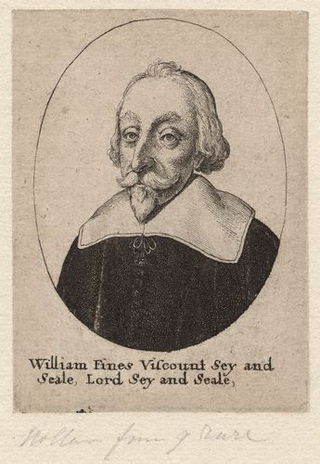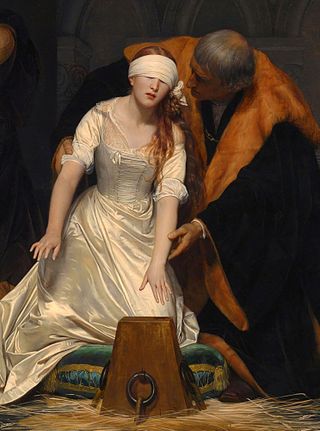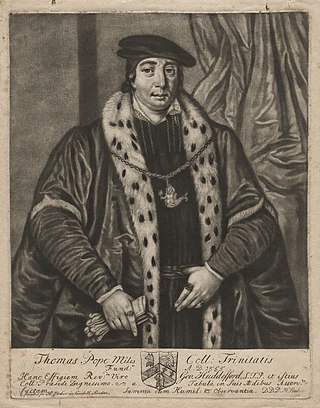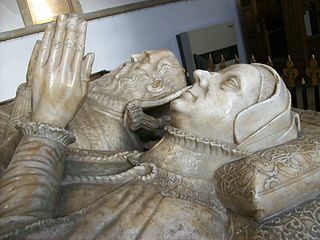Related Research Articles

Richard Temple-Nugent-Brydges-Chandos-Grenville, 1st Duke of Buckingham and Chandos, styled Earl Temple from 1784 to 1813 and known as the Marquess of Buckingham from 1813 to 1822, was a British landowner and politician.

Sir Thomas Wyatt the Younger was an English politician and rebel leader during the reign of Queen Mary I; his rising is traditionally called "Wyatt's rebellion". He was the son of the English poet and ambassador Sir Thomas Wyatt.

William Fiennes, 1st Viscount Saye and Sele was an English nobleman and politician. He was a leading critic of Charles I's rule during the 1620s and 1630s. He was known also for his involvement in several companies for setting up overseas colonies.

John Brydges, 1st Baron Chandos was an English courtier, Member of Parliament and later peer. His last name is also sometimes spelt Brugge or Bruges. He was a prominent figure at the English court during the reigns of Kings Henry VIII and Edward VI and of Queen Mary I.

Catherine Carey, after her marriage Catherine Knollys and later known as both Lady Knollys and Dame Catherine Knollys,, was chief Lady of the Bedchamber to Queen Elizabeth I, who was her first cousin.

Edward Fiennes, or Clinton, 1st Earl of Lincoln KG was an English landowner, peer, and Lord High Admiral. He rendered valuable service to four of the Tudor monarchs.

Sir Thomas de Hungerford of Farleigh Castle in Somerset, was the first person to be recorded in the rolls of the Parliament of England as holding the office of Speaker of the House of Commons of England, although that office had existed before his tenure.

Henry Norris, 1st Baron Norreys of Rycote in Oxfordshire, was an English politician and diplomat, who belonged to an old Berkshire family, many members of which had held positions at the English court.

Sir Thomas Pope, was a prominent public servant in mid-16th-century England, a Member of Parliament, a wealthy landowner, and the founder of Trinity College, Oxford.
Giles Bruggeof Cubberley, 6th Baron Chandos born in Cubberley, Gloucester, England. The son of Thomas Brugge, 5th Baron Chandos, and Florence Darrell. Giles took part in the Battle of Blackheath on 22 June 1497 from which he was knighted for valour. He married Isabel Baynham, daughter of Thomas Baynham and Alice Walwyn. He held the office of High Sheriff of Gloucestershire for 1499.
Sir Richard Sackville of Ashburnham and Buckhurst in Sussex and Westenhanger in Kent; was an English administrator and Member of Parliament.

John Williams, 1st Baron Williams of Thame was Master of the Jewels and Lord President of the Council of the Welsh Marches. He was summoned to parliament as Lord Williams of Thame on 17 February 1554.
Sir Anthony Lee was an English courtier and Member of Parliament, and the father of Elizabeth I's champion, Sir Henry Lee. He was at the court of Henry VIII in his youth, and served as a Justice of the Peace and Knight of the Shire for Buckinghamshire. He was a close friend of his brother-in-law, the poet Sir Thomas Wyatt.

Sir Anthony Cope of Hanwell, near Banbury, was an English knight, author, principal chamberlain to Queen Catherine Parr, and sheriff of Oxfordshire and Berkshire.

Sir Edmund Walsingham of Scadbury Hall, Chislehurst in Kent, was a soldier, Member of Parliament, and Lieutenant of the Tower of London during the reign of King Henry VIII.

Sir Henry Lee KG, of Ditchley, was Queen's Champion and Master of the Armouries under Queen Elizabeth I of England.

Sir Matthew Arundell of Wardour Castle in Wiltshire, known between 1552 and 1554 as Matthew Howard and after his death sometimes called Matthew Arundell-Howard, was an English gentleman, landowner, and member of parliament in the West of England.
Anthony Carleton was a landowner and Member of Parliament, and the father of Dudley Carleton, 1st Viscount Dorchester.
This is a list of Sheriffs of Berkshire and Oxfordshire. One sheriff was appointed for both counties from 1248 until the end of 1566, after which separate sheriffs were appointed. See High Sheriff of Berkshire and High Sheriff of Oxfordshire for dates before 1248 or after 1566.
Francis George Spencer, 2nd Baron Churchill,, was a British peer and diplomat from the Spencer family.
References
- Ashley, Roger (January 2008) [2004]. "Brydges, Thomas (d. 1559)". Oxford Dictionary of National Biography (online ed.). Oxford University Press. doi:10.1093/ref:odnb/3810.(Subscription or UK public library membership required.)
- Attribution
 This article incorporates text from a publication now in the public domain : Lee, Sidney (1886). "Brydges, John". In Stephen, Leslie (ed.). Dictionary of National Biography . Vol. 7. London: Smith, Elder & Co. pp. 164–165.
This article incorporates text from a publication now in the public domain : Lee, Sidney (1886). "Brydges, John". In Stephen, Leslie (ed.). Dictionary of National Biography . Vol. 7. London: Smith, Elder & Co. pp. 164–165.